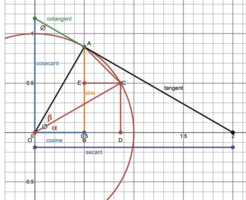Can anyone point me to some resources that show the proof/reasoning behind the trig ratios? Not the trig identities, but the ratios. Why does sin x = opp/hyp? Why does tan x = opp/adj? I have the ratios memorized, but I don't understand the deeper relationship between all the parts (sides, angles, etc.) and why those ratios specifically lead to the answer. For example, cos 60 = 1/2 because that's the ratio of adj/hyp. Great, but why?
You are using an out of date browser. It may not display this or other websites correctly.
You should upgrade or use an alternative browser.
You should upgrade or use an alternative browser.
Trigonometric Ratios: resources that show the proof/reasoning behind the trig ratios?
- Thread starter jpanknin
- Start date
skeeter
Elite Member
- Joined
- Dec 15, 2005
- Messages
- 3,215
To expand a little,
When looking at the image attached, triangle [imath]\angle AOB[/imath] has a central angle of [imath]60\degree[/imath], meaning [imath]sin = \frac{\sqrt{3}}{2}[/imath], [imath]cos = \frac{1}{2}[/imath] and [imath]tan = \frac{\frac{\sqrt{3}}{2}}{\frac{1}{2}} = \sqrt{3}[/imath]
But why do these relationships exist? It seems like magic that [imath]cos 60\degree = \frac{1}{2}[/imath]. Why does it equal [imath]\frac{1}{2}[/imath]? Most of what I've found online says that [imath]cos 60\degree = \frac{1}{2}[/imath] because that's the ratio of [imath]\frac{adj}{hyp}[/imath]. That seems a bit circular and incomplete as an explanation. I'm looking for why these relationships exist, not just a restatement of the ratios themselves.[/imath]
When looking at the image attached, triangle [imath]\angle AOB[/imath] has a central angle of [imath]60\degree[/imath], meaning [imath]sin = \frac{\sqrt{3}}{2}[/imath], [imath]cos = \frac{1}{2}[/imath] and [imath]tan = \frac{\frac{\sqrt{3}}{2}}{\frac{1}{2}} = \sqrt{3}[/imath]
But why do these relationships exist? It seems like magic that [imath]cos 60\degree = \frac{1}{2}[/imath]. Why does it equal [imath]\frac{1}{2}[/imath]? Most of what I've found online says that [imath]cos 60\degree = \frac{1}{2}[/imath] because that's the ratio of [imath]\frac{adj}{hyp}[/imath]. That seems a bit circular and incomplete as an explanation. I'm looking for why these relationships exist, not just a restatement of the ratios themselves.[/imath]
Attachments
Thanks, @skeeter. That's helpful. Not exactly what I was looking for, but that article had some things that I wasn't aware of.
Yes, I can see that and work it out. But my next question would be: why is cos defined as [imath]\frac{adj}{hyp}[/imath]? Where did that come from? I'm trying to dig deeper on this and really understand the intuition behind all of the trig relationships.Imagine taking an equilateral triangle and bisecting one of the interior angles over to the opposite side. You now have two 30-60-90 triangles. Can you now see that:
\(\displaystyle \cos(60^°)=\frac{1}{2}\)?
BigBeachBanana
Senior Member
- Joined
- Nov 19, 2021
- Messages
- 2,181
Dividing the adjacent side by the hypotenuse in the definition of cosine is done to standardize the calculation of the cosine of an angle in terms of a unit circle. In a unit circle, the radius is 1 unit, and therefore the hypotenuse of a right triangle formed by an angle in the unit circle is also 1 unit. By using the ratio of the adjacent side to the hypotenuse, we can calculate the cosine of the angle and standardize the result to a value between -1 and 1, regardless of the size of the triangle or circle. This works because of similar triangles. This standardization makes it easier to compare the cosine values of different angles or to use cosine in various calculations and applications.Yes, I can see that and work it out. But my next question would be: why is cos defined as [imath]\frac{adj}{hyp}[/imath]? Where did that come from? I'm trying to dig deeper on this and really understand the intuition behind all of the trig relationships.
Similar idea for sine.
A slightly different "angle."
The practical use of the trigonometric functions goes back at least as far as the Greek-speaking mathematicians, who used it for practical things like architecture and astronomy. All sorts of angles may arise in the course of a practical application. In general, the trigonometric functions are irrational numbers, which means that for practical purposes, we must use approximations. In the old days, you had to look those up in cumbersome tables that were time consuming to use and easy to make mistakes with.
The so-called "special" angles happen to arise often in practical problems and to have easily memorable values. So, we ask students to memorize them and build problems using them. But there is nothing particularly peculiar about those angles in terms of pure mathematics. They are frequently practically useful and have trig values that are easy to rememeber, but they are not mathematically special.
The practical use of the trigonometric functions goes back at least as far as the Greek-speaking mathematicians, who used it for practical things like architecture and astronomy. All sorts of angles may arise in the course of a practical application. In general, the trigonometric functions are irrational numbers, which means that for practical purposes, we must use approximations. In the old days, you had to look those up in cumbersome tables that were time consuming to use and easy to make mistakes with.
The so-called "special" angles happen to arise often in practical problems and to have easily memorable values. So, we ask students to memorize them and build problems using them. But there is nothing particularly peculiar about those angles in terms of pure mathematics. They are frequently practically useful and have trig values that are easy to rememeber, but they are not mathematically special.

